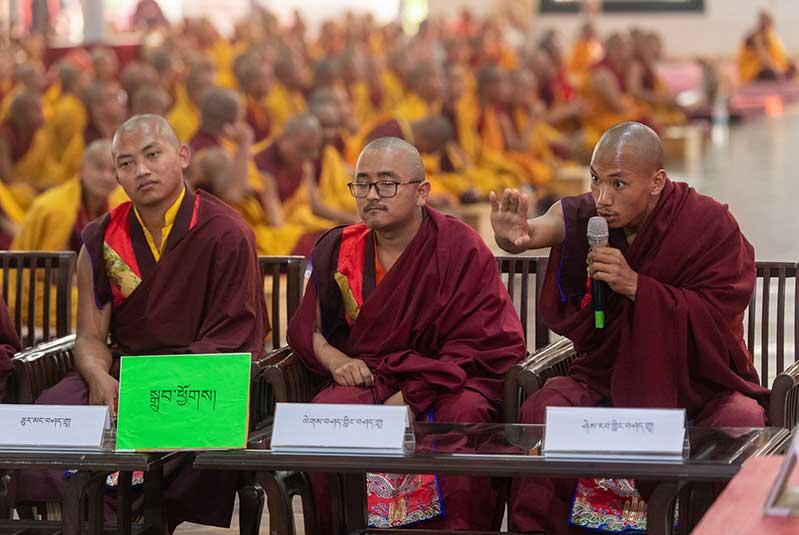
Monlam Pavillion
January 29, 2020
On this second day of the Pre-Monlam teachings, eight monks, selected from Karma Kagyu shedras (monastic colleges) and monasteries, participated in a western-style debate on the topic, “Is it proper for monastics to eat meat?” Khenpo Pema Osel from Surmang monastery moderated.
Undaunted by the relatively novel format, an appreciative and rapt audience cheered on the two well-matched sides. The topic had obvious traction for the assembled sangha, and the Gyalwang Karmapa’s inclusion of a short section of comments from audience members within the debate format proved especially welcome. The teams were armed with logical points and seemingly endless quotations from the rich textual and oral traditions of Tibetan Buddhism. To name just some of the many sources referenced, Longchen Rabjam, Guru Rinpoche, the Kalachakra tantra, Mikyo Dorje, Sakya Pandita, the Vinaya (the monastic code for conduct), the Heart Sutra, and the Dalai Lama and Gyalwang Karmapa all made cameo appearances. As one observer commented, “The debate was awesome.”
Speaking first, the Opponents pointed out the Buddha’s consistent opposition to monastics consuming meat, but the Proponents countered that the Buddha had left room for sangha members to accept meat offered as alms, provided it had not been killed specifically for the monks. Side Opposition then argued that eating meat leads to animals being killed, which no Buddhist should encourage. Indeed, monastics should cultivate compassion toward all sentient beings and help to liberate them, not causing them fear and pain. Side Proposition countered that the key to liberating beings is to form a connection with them, and many texts note that even a negative connection can be enough to liberate a being. For example, someone who throws a stone at a high lama forms a connection that could eventually result in enlightenment. Thus, while being killed and eaten is terrible karma in this life, if the animal is eaten by a pure monk with bodhicitta, in a future life that animal could truly benefit. Another argument on the Proponent side was the primacy of motivation over results in the Tibetan understanding of karmic cause and result. One could potentially eat meat with a compassionate attitude. Team members also argued that many more beings are killed by pesticides used to grow vegetables; indeed, a single bowl of rice was full of the deaths of countless tiny sentient beings. Was it not better to eat one large animal, and to wear its skin?
An interesting aspect of the debate was the use of modern science. While quotations from traditional texts dominated, both sides did attempt to leverage current research on nutrition and
biology. Side Opposition argued that a vegetarian diet is healthier, that meat causes many modern afflictions such as hypertension and heart disease, and that the production process of meat is bad for the climate. The Proponents argued that monks need healthy bodies in order to practice the dharma and in particular they need protein. In parts of Tibet, it is so cold that meat-eating is necessary for survival.
Judging from the lively exchange, the expressions of awe and delight on the faces of the audience, the many interesting questions and comments raised, and the frequent laughter and cheers, this debate was a ringing success, and perhaps a model for future events.


































